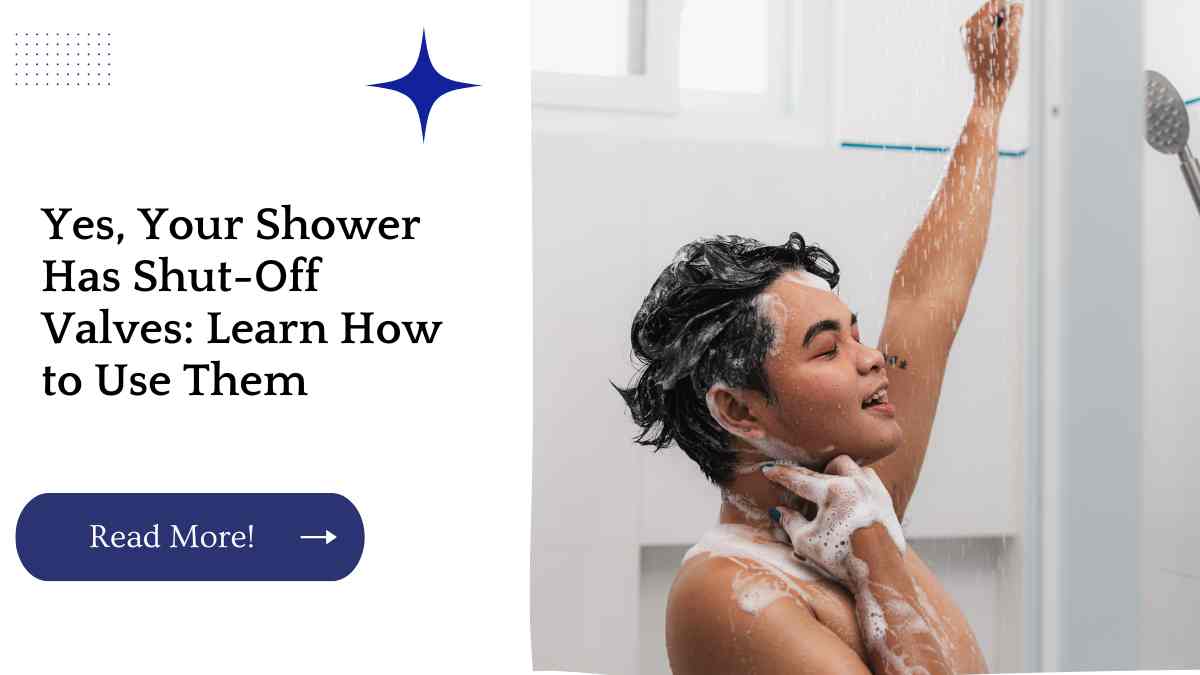As a homeowner or renter, you may be familiar with the basic functioning of your shower, but there is a small but essential component that often goes overlooked – the shut-off valves. These valves are installed to allow you to turn off the water supply to your shower without affecting the rest of your plumbing.
If you ever need to replace your showerhead or repair a leaky faucet, knowing how to use these valves can save you time and hassle. In this article, we’ll discuss what shut-off valves are, why they are important, and how to use them correctly.
| Key Takeaways |
|---|
| Understanding the purpose and function of shut-off valves is crucial for any homeowner or renter. |
| Different types of shut-off valves include inline valves, gate valves, and ball valves. |
| Shut-off valves can be found in various locations, including behind the showerhead, inside the wall, or in the basement or crawl space. |
| Shut-off valves are important because they allow you to turn off the water supply to your shower without affecting the rest of your plumbing. |
| Proper use and maintenance of shut-off valves can help prevent leaks, corrosion, and difficulty turning the valve. |
| Common problems with shut-off valves include leaks, corrosion, and difficulty turning the valve. |
| Faulty shut-off valves can often be fixed with simple repairs or replacement. |
What are Shower Shut-Off Valves?
Shower shut-off valves are small valves installed on the water pipes leading to your shower. They allow you to control the flow of water to your shower and turn off the water supply when needed.
Shut-off valves are typically installed to allow for easy maintenance or repair of your shower’s plumbing fixtures without having to shut off the water supply to the entire house.
If your shower diverter has fallen out, don’t panic! It’s a common issue that can easily be fixed with the right tools. Check out our quick and easy fixes for a shower diverter to get your shower back in working order.
Types of Shut-Off Valves
There are three main types of shut-off valves used in shower plumbing: inline valves, gate valves, and ball valves.
Inline Valves
Inline valves are small, cylindrical valves that are installed in the water pipes leading to your shower. They are typically installed near the showerhead and can be turned on or off by turning a small lever or knob.
Gate Valves
Gate valves are larger valves that are installed on the water pipes leading to your shower. They feature a gate or wedge-shaped disc that can be lowered into the valve body to stop the flow of water. Gate valves are typically turned on or off by turning a large wheel or handle.
Are you experiencing low water pressure in your shower? This may be a sign that your showerhead needs attention. Check out our article on boosting your shower pressure with a simple fix for helpful tips on how to address this frustrating issue in a few simple steps.
Ball Valves
Ball valves are another type of valve commonly used in shower plumbing. They feature a ball-shaped disc with a hole in the middle that can be rotated to allow or block the flow of water. Ball valves are typically turned on or off by rotating a lever or handle.
Where to Find Shut-Off Valves
Shut-off valves can be located in a variety of places, depending on the plumbing setup of your shower. Some common locations include:
Some common locations of shut-off valves in a shower include behind the showerhead, inside the wall, or in the basement or crawl space. Inline valves are often installed near the showerhead, while gate valves and ball valves may be located farther away, such as in the basement or crawl space.
If you’re unsure where your shut-off valves are located, check your home’s plumbing diagram or consult with a plumber. It’s important to know where they are in case of an emergency or when performing maintenance or repairs.
A leaky basement shower can be a frustrating problem to solve, but don’t worry – there are solutions. Our article on quick and easy fixes for a basement shower leak offers helpful tips to help you identify and address the issue.
Why are Shut-Off Valves Important?
Shut-off valves are important because they allow you to turn off the water supply to your shower without affecting the rest of your plumbing. This can be useful when you need to repair a leaky faucet or replace the showerhead, as you won’t need to turn off the water supply to your entire house.
Shut-off valves can also help prevent water damage in the event of a plumbing emergency, such as a burst pipe or a major leak. By quickly turning off the water supply to your shower, you can prevent water from flooding your bathroom or damaging your home.
How to Use Shut-Off Valves
Knowing how to use shut-off valves is essential for any homeowner or renter. Here’s a step-by-step guide to using shut-off valves in your shower:
Turning Off the Water Supply
- Locate the shut-off valve for your shower. This may be located near the showerhead, inside the wall, or in the basement or crawl space.
- Turn the valve handle or lever clockwise to shut off the water supply to your shower.
- Check to make sure the water has stopped flowing before starting any maintenance or repairs.
Turning the Water Back On
- Once you’ve completed your maintenance or repairs, turn the shut-off valve handle or lever counterclockwise to turn the water supply back on.
- Turn on the shower and check for any leaks or issues.
Maintaining Shut-Off Valves
Proper maintenance of shut-off valves can help prevent leaks, corrosion, and difficulty turning the valve.
Here are some tips for maintaining your shut-off valves:
- Test your shut-off valves periodically to make sure they are working properly.
- If you notice any leaks or corrosion, have your shut-off valves inspected and repaired by a professional plumber.
- Keep your shut-off valves clean and free of debris to ensure smooth operation.
- Consider replacing older shut-off valves with newer, more durable models.
If you’re looking to create an efficient laundry setup, it’s important to pay attention to your washing machine and sink drainage. Check out our guide on washing machine and sink drainage tips to learn more about maximizing the efficiency of these crucial components.
Common Problems with Shut-Off Valves
Like any plumbing component, shut-off valves can experience problems over time. Here are some common issues to look out for:
Leaks
Leaking shut-off valves can be caused by a variety of issues, including worn-out seals, loose connections, or corroded valve bodies. If you notice any leaks, it’s important to have them inspected and repaired as soon as possible to prevent water damage to your home.
Corrosion
Over time, shut-off valves can become corroded due to exposure to water and other elements. Corrosion can make it difficult to turn the valve handle or lever, or cause leaks. If you notice any signs of corrosion, have your shut-off valves inspected and replaced if necessary.
Difficulty Turning the Valve
If you have trouble turning your shut-off valve handle or lever, it could be due to corrosion, debris buildup, or wear and tear. Try cleaning the valve and lubricating the handle or lever with a silicone-based lubricant. If the problem persists, consider having the valve inspected and repaired or replaced.
Fixing a Faulty Shut-Off Valve
If you have a faulty shut-off valve that is leaking, corroded,
Continue writing please
or difficult to turn, there are a few steps you can take to fix the problem. However, if you’re not comfortable working with plumbing components, it’s best to leave the repairs to a professional plumber.
Here are some basic steps to fix a faulty shut-off valve:
- Turn off the water supply to your shower using the shut-off valve.
- Remove any debris or buildup around the valve handle or lever.
- Try turning the valve handle or lever again. If it’s still difficult to turn, try lubricating it with a silicone-based lubricant.
- If the valve is still leaking or not working properly, you may need to replace it. Consult with a professional plumber to determine the best course of action.
Water damage caused by a shower leak can be a nightmare to deal with, but it doesn’t have to be. Our article on fixing drywall damage caused by a shower leak provides useful information on how to identify and address common sources of water damage.
Frequently Asked Questions
Why do I need shut-off valves in my shower?
A: Shut-off valves allow you to turn off the water supply to your shower without affecting the rest of your plumbing. This can be useful when you need to repair a leaky faucet or replace the showerhead, as you won’t need to turn off the water supply to your entire house.
Where are shut-off valves located in a shower?
A: Shut-off valves can be located in a variety of places, including behind the showerhead, inside the wall, or in the basement or crawl space.
What are the different types of shut-off valves?
A: The three main types of shut-off valves used in shower plumbing are inline valves, gate valves, and ball valves.
How do I turn off the water supply to my shower using a shut-off valve?
A: To turn off the water supply to your shower using a shut-off valve, locate the valve handle or lever and turn it clockwise until the water stops flowing.
What should I do if my shut-off valve is leaking?
A: If your shut-off valve is leaking, have it inspected and repaired by a professional plumber as soon as possible to prevent water damage to your home.
Further Reading
What is a Shower Valve with Stops? – A comprehensive guide to understanding shower valves with stops and their functions.
Shower Head Shut Off Valve – An online store that offers shower head shut off valves, including their features and pricing.
K1140B Shower Shut-Off Valve – A product listing of a shower shut-off valve on Amazon with detailed information on specifications and installation instructions.
Conclusion
In conclusion, shut-off valves are a crucial component of your shower’s plumbing system that allow you to control the flow of water to your shower and turn off the water supply when needed. Knowing how to use and maintain shut-off valves can help prevent leaks, corrosion, and difficulty turning the valve.
By following the tips and guidelines outlined in this article, you can ensure that your shut-off valves are working properly and protect your home from potential water damage.

Hellen James is the author of the blog and a licensed plumber with over 15 years of experience. She shares her knowledge and experience in plumbing and drainage through insightful and informative articles

